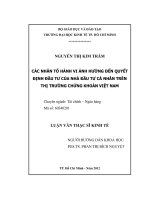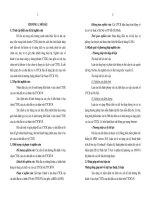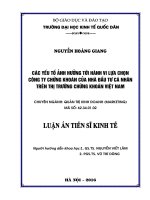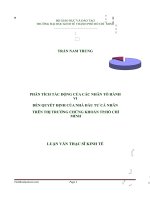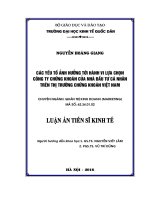Ảnh hưởng của tâm lý nhà đầu tư đến chỉ số thị trường chứng khoán: Bằng chứng thực nghiệm tại 6 nước Đông Nam Á
Bạn đang xem bản rút gọn của tài liệu. Xem và tải ngay bản đầy đủ của tài liệu tại đây (255.32 KB, 12 trang )
INTERNATIONAL CONFERENCE FOR YOUNG RESEARCHERS IN ECONOMICS & BUSINESS 2020
ICYREB 2020
INVESTOR SENTIMENT AND STOCK MARKET INDICES:
EVIDENCE FROM ASEAN -6 COUNTRIES
ẢNH HƯỞNG CỦA TÂM LÝ NHÀ ĐẦU TƯ ĐẾN CHỈ SỐ
THỊ TRƯỜNG CHỨNG KHỐN: BẰNG CHỨNG THỰC NGHIỆM
TẠI 6 NƯỚC ĐƠNG NAM Á
Nguyễn Phùng Hải Thanh - Phạm Thy Khánh Linh
Hồ Minh Hồng - ThS. Nguyễn Ngọc Trâm
Đại học Kinh tế quốc dân
Abstract
This paper examines the impact of investor sentiment on the stock market indexes of 6
Asian countries, using data sets from 6 countries from 2010 to 2019 and applying the Random
effect model method.
This paper found evidence of a positive effect of investor sentiment on stock market index.
Research results imply that investors, market participants as well as policymakers need to pay
more attention to investor sentiment and its impact on the stock market.
Keywords: ASEAN, investor sentiment, stock market index.
Tóm tắt
Bài viết nghiên cứu vấn đề tác động của tâm lý nhà đầu tư đến chỉ số thị trường chứng
khoán của 6 nước châu Á, sử dụng bộ dữ liệu từ 6 quốc gia từ năm 2010 đến năm 2019 và áp
dụng phương pháp mơ hình tác động ngẫu nhiên.
Bài viết tìm thấy bằng chứng về tác động tích cực của tâm lý nhà đầu tư (investor sentiment)
tới chỉ số chứng khoán. Kết quả nghiên cứu hàm ý rằng nhà đầu tư, các chủ thể tham gia thị
trường, và đặc biệt các nhà hoạch định chính sách cần quan tâm nhiều hơn tới tâm lý nhà đầu
tư (investor sentiment) và ảnh hưởng của nó tới thị trường chứng khốn.
Từ khóa: Asean, tâm lý nhà đầu tư, chỉ số thị trường chứng khoán.
1. Introduction
Traditional standard finance rarely considers psychological factors as important components, which may help to offer a good explanation for stock price behavior. Behavioral finance
is a sub-field of financial research, that studies the influence of psychology on the behavior of
investors. This field focuses on the fact that not all investors are rational and self-controlled, and
are influenced by their own biases. Behavioral finance is becoming more important to finance
research because of its explanatory power for market anomalies. Numerous studies on the effect
1140
INTERNATIONAL CONFERENCE FOR YOUNG RESEARCHERS IN ECONOMICS & BUSINESS 2020
ICYREB 2020
of behavior components find that it plays an important role in affecting stock market volatility
and returns.
On the other hand, Vietnam, as well as other markets in Southeast Asia are being assessed
as containing such opportunities in the coming years. Therefore, the financial market should be
focused on the corresponding development. The stock market linkage will create a common playground for financial investors in the region. It not only opens up opportunities for investors, securities companies to conduct cross-border securities transactions quickly, safely, and efficiently,
but also facilitates the Enterprises of ASEAN countries can list shares on each other’s stock exchanges to raise capital and enhance liquidity. However, it cannot be denied that, even if it is a
big playing field, there will be risks. The playing field is large, the number of investors will be
very large, so the influence of investor sentiment will also be much greater. Moreover, at present,
there are not many studies on the impact of investor sentiment on Southeast Asia’s stock market.
Though receiving less attention in comparison to other developed markets, the Southeast Asian
region is still considered to have the potential for development in the future.
Recognizing this, our research team decided to choose the topic “Investor sentiment and
Stock market indexes: evidence from ASEAN-6 countries” (ASEAN-6 is the top 6 economies in
the East region South Asia: Indonesia, Malaysia, Thailand, Singapore, Philippines, and Vietnam)
to examine whether Investor sentiment factor could explain the volatility and stock return or not,
with the desire to give domestic and foreign investors a more specific understanding of the impact
of psychological factors, thereby avoiding unfortunate mistakes, manage risks, seizing investment
opportunities in the Southeast Asian market, and give recommendations for policymakers in controlling the financial system to limit negative effects of investor sentiment in the stock market.
2. Literature review
In the world, there are many research papers on the impact of investor sentiment on the
stock market. Lee, Jiang, Indro (2002) explored stock market volatility, excess returns, and the
role of investor sentiment. The results showed that the excess profit was positively correlated
with the change of investor sentiment; However, Brown & Cliff (2004) studied the relationship
between investor sentiment and stock market returns in the short term. The results show that sentiment has little predictability for a stock return shortly. Ho, Chien – Wei (2012) pointed out the
positive and negative effects of investor sentiment on asset valuation on the stock market, at the
same time; Zhu & Niu (2016) analyzed the mechanism that affects investor sentiment and accounting information on stock prices in the stock market. The empirical results show that investor
sentiment can change both expected earnings growth and required return, thus affecting stock
prices;… Investor sentiment in the market finance reflects investor’s attitude to market developments, it can control the stability of the market, especially the financial market. The psychological
factor is very complex, highly volatile potential, is one of the factors causing market panic, contrary to expectations.
Most studies on this field utilize the U.S., European data in their tests. For example, Jansen,
W. Jos, and Nahuis, J. Niek (2003) found that stock returns and changes in sentiment are positively
correlated for nine European countries, with Germany the main exception. Dergiades, T. (2012)
found that sentiment embodies significant predictive power concerning stock returns on the U.S.
1141
INTERNATIONAL CONFERENCE FOR YOUNG RESEARCHERS IN ECONOMICS & BUSINESS 2020
ICYREB 2020
market. Ho, Chien – Wei (2012) explore that the impacts of investor sentiment on stock returns
and volatility are country-specific, the study finds high investor sentiment level is followed by a
low excess market return for most counties such as the U.S., France, and Italy, with Japan as the
only exception where exists a positive sentiment- return relationship, but there is no significant
effect for the rest of the sample countries examined (include U.S., European and Asia – Pacific
stock markets).
In this paper, we attempt to discover the role of investor sentiment in international stock
markets in 6 Asian countries during 2010 and 2019.
3. Theoretical framework
This study investigates the roles of investor sentiment in international stock markets by
examining how the investor sentiment index is related to the stock price index in 6 Southeast
Asian countries.
According to the EMH, investors, both institutional and individual, are unemotional and
rational, cannot beat the market and the market is information efficient. All information about
the fundamental value and new announcements is fully reflected in prices. Despite its theoretical
success, many researchers argue that investors in general are not fully rational. Even more,
Shiller’s (1981) empirical volatility test suggests that the stock market is more fluctuating than
the forecasts which following market efficiency. His finding shows that investors and stock prices
could be affected by other factors irrelevant to fundamentals.
In addition to EMH, there are many classical asset pricing theory that describes risk and
return, not only from the past data and firm characteristics but also on exposure to systematic
risk (CAPM) or multifactor model (APT, FF…). These models may be more plausible as a reasonable model for explaining the average asset returns, a drawback of the approach is that it does
not offer a good explain pricing anomalies in the financial market. Roll & Ross’s (1980) test argues that not all investors use risk measurements for their decision-making process. And many
factors do not seem to exist entirely in the real market.
Being an important field in finance, behavioral finance applies a psychological factor to
the study, that focuses on the way investors receive and process information during making their
decision. Baker and Wurgler (2006) argue that some anomalies in the stock market can be caused
by noise traders which are motivated by something other than fundamental information. Even
more, the existence of anomalies implies that either financial markets are inefficient or traditional
asset pricing models are inadequately specified.
In this paper, we examine whether investor sentiment helps to describe the unexpected
volatility and the anomalies in the stock market as a component in model specifications.
4. Methodology
4.1. Data collection
In this paper, we use quarterly data for 10 years from 2010 to 2019 of six ASEAN countries
(Vietnam, Philippines, Malaysia, Thailand, Indonesia, and Singapore). We decide to use data consisting of only six ASEAN countries because of data availability. Investor sentiment data is collected from Nielsen quarterly reports, while stock indices and data on macroeconomic factors
1142
INTERNATIONAL CONFERENCE FOR YOUNG RESEARCHERS IN ECONOMICS & BUSINESS 2020
ICYREB 2020
are collected from the IMF (International Monetary Fund) databases. Our final sample consists
of 240 observations.
4.2. Key variables defined
4.2.1. Dependent variable
The dependent variable in our model is the stock index. We use six stock indices including
the VN-Index of Vietnam, PSE (Philippines Stock Exchange Index) of Philippines, JCI (Jakarta
Stock Exchange Composite Index) of Indonesia, SET (Stock Exchange of Thailand SET Index)
of Thailand, FTSE Bursa Malaysia KLCI (Kuala Lumpur Composite Index) of Malaysia and STI
(Straits Times Singapore Index) of Singapore.
4.2.2. Independent variable
We find that the Consumer Confidence Index (CCI) has received attention in previous research papers as a potential measure for investor optimism. Research of Fisher and Statman
(2002) showed a positive correlation between consumer confidence and investor sentiment (compiled by the American Association of Individual Investors - AAII) during the period from 1987
to 2000. CCI also reflects consumer sentiment about the current state and prospect in the future
of the economy and business cycle, which affects financial markets, especially a large proportion
of individual investors. Therefore, this paper will use the Consumer Confidence Index to represent
investor sentiment.
Data on Consumer Confidence Index for six countries were collected through quarterly reports by Nielsen, a company that measures global business performance. Consumer Confidence
Index is an adjusted monthly measurement.
4.2.3. Control variable
Control variables in this model include 1-Year Government Bond Yield, Consumer Price
Index (CPI), and Gross Domestic Product (GDP). The government bond yield is the interest paid
on the ownership of a government bond (issued in local and foreign currencies) or in other words,
the government bond yield is the interest rate at which the government of the country can borrow.
The Consumer Price Index measures the average price of the basket of goods and services purchased by a typical consumer. This is an indicator reflecting the trend and volatility of retail prices
of consumer goods and services used in the daily life of the population and households. Therefore,
it is used to track the change in the cost of living over time. Gross Domestic Product is the basic
index to evaluate the economic development of a country or territory, calculated by the market
value of all final goods and services produced within a country or territory for a certain time.
The relationship between 1-Year Government Bond Yield and the stock price index is expected that when the 1-Year Government Bond Yield increases, the return of securities will decrease, as concluded by Pesaran & Timmermann (1994). Bulmash & Trivoli (1991) also found
that there is a negative relationship between the current US stock price and the Treasury bill rate.
According to research by Wongbangpo & Sharma (2002), they believe that CPI is a representative
factor for the inflation rate, they also examined the relationship between CPI and stock market
index in five Asian countries (Indonesia, Malaysia, Philippines, Singapore, and Thailand) and
concluded that CPI negatively affects stock market index because higher prices will lead to an
1143
INTERNATIONAL CONFERENCE FOR YOUNG RESEARCHERS IN ECONOMICS & BUSINESS 2020
ICYREB 2020
increase in production costs and a decrease in future profits. Chatrath (1997) found a negative
relationship between stock return and inflation when he examines how the inflation rate affects
the performance of the market of India. Omran & Pointon (2001) also studied the relationship
between inflation and stock prices of the Egyptian market and they found a negative relationship
between them. Research by Ademola (2014) in the Nigerian market has shown that GDP has a
positive effect on stock market returns because the higher the GDP growth rate, the more developed the economy and the stock returns will increases. Fama (1981) also found a strong positive
correlation between stock returns and GDP.
Our variables are presented in the following table 1.
Variables
Dependent
variable
Stock index
return
Table 1: Variables in the model
Construction
Source
lnRETURN: Natural logaIMF databases
rithm of stock price index of
each country
Independent Consumer Confi- CCI: Consumer Confidence Nielsen reports
dence Index
Index (quarterly)
Variable
Control
variable
Government
Bond Yield
Consumer
Price Index
GBY: 1 Year Government
Bond Yield (%)
Expectation
Positive
IMF databases
Negative
lnCPI: Natural logarithm of IMF databases
Consumer Price Index (CPI)
Negative
Gross Domestic lnGDP: Natural logarithm of IMF databases
Product
Gross Domestic Product
(GDP)
Positive
(Source: Authors’ synthesis)
4.3. Model
This research analyzes the data in both cross-sectional and time-series dimensions, so the
panel data model is the most suitable regression model. Moreover, this model also shows more
diverse information, more degrees of freedom, better performance, and less multicollinearity between variables. For a panel data type regression model, the three most common regression methods are (1) Pooled OLS, (2) Fixed Effects Model (FEM), and (3) Random Effects Model (REM).
The Pooled OLS model is the simplest and most rudimentary approach assuming that both
the intercept and the angular coefficients do not change with time and space.
lnRETURNi,t = β0 + β1CCIi,t + β2GBYi,t + β3lnCPIi,t + β4lnGDPi,t + ui,t (1)
However, the above model does not answer the question of whether the market index has
changed between countries over time because it grouped all the observations even though countries have differences. This is inconsistent with the fact that each country is a separate entity with
its own characteristics, so the Pooled OLS model can lead to consequences such as the occurrence
1144
INTERNATIONAL CONFERENCE FOR YOUNG RESEARCHERS IN ECONOMICS & BUSINESS 2020
ICYREB 2020
of correlation between random error and independent variable, assumptions about the classical
linear regression model are violated, the estimation results are biased and unstable.
The Fixed Effects Model (FEM) model fixes this problem by assuming the intercept for
each country is different and remains constant over time.
lnRETURNi,t = βi + β1i,tCCIi,t + β2i,tGBYi,t + β3i,tlnCPIi,t + β4i,tlnGDPi,t + ui,t(2)
Although the disadvantages of the Pooled OLS model have been improved and it is easy
to apply, the FEM approach in panel data processing still has some limitations such as small degrees of freedom if the sample size is small. Therefore, in panel data analysis we can also approach
the Random Effects Model (REM) model. From the FEM model, the intercept βi can be expressed
as βi = γ1 + εi. Instead of considering the intercept βi of countries fixed effect, we consider this
intercept as a random variable with mean γ1 and εi as a random error with mean zero and constant
variance σ2ε.
lnRETURNi,t = γ1 + β1i,tCCIi,t + β2i,tGBYi,t + β3i,tlnCPIi,t + β4i,tlnGDPi,t + ui,t +εi
= γ1 + β1i,tCCIi,t + β2i,tGBYi,t + β3i,tlnCPIi,t + β4i,tlnGDPi,t + wi,t (3)
To make the decision to choose between three models, this paper will conduct two of the
three tests: Hausman Test, Breusch - Pagan Lagrange Multiplier Test, F-test according to the following procedure.
5. Summary statistics
Picture 1: Test process diagram
(Source: Authors’ synthesis)
The summary statistics are presented in Table 2, which shows that the variables in the paper
have quite small standard deviations, which means the variation is relatively uniform. However,
the CCI varied strongly in the range 135 to 78 with a standard deviation of 12,652 because this
variable has a large value.
1145
INTERNATIONAL CONFERENCE FOR YOUNG RESEARCHERS IN ECONOMICS & BUSINESS 2020
ICYREB 2020
Variables
N
Mean
St. Dev.
240
109.062
12.652
240
4.640
0.116
lnRETURN
240
GBY
240
CCI
lnCPI
lnGDP
Table 2: Summary statistics
240
7.711
3.576
4.361
Min
Max
0.822
5.964
9.056
2.543
0.235
12.869
0.538
2.744
5.648
78
4.209
135
4.932
Skewness Kurtosis
0.0651
0.0000
0.0000
0.0006
0.4430
0.1447
0.2593
0.0000
0.0004
0.2104
(Source: Authors’calculation)
The correlation matrix in Table 3 shows that the correlation coefficient between the independent variables is not high. This correlation matrix table also shows a preliminary correlation
between the dependent variable and the independent variables. While three variables CCI, lnCPI,
lnGDP are positively correlated with the lnRETURN, GBY has a negative correlation. This is
completely consistent with the fact that when the consumer confidence index increases, it means
that consumer’s attitude towards the economy is completely positive, causing the market index
to increase. Similar to CPI and GDP, when these two indexes increase, it means that the economy
develops well and has a positive impact on the stock price index. When government bond yield
increases, investors tend to turn to buy government bonds for safety. Conversely, when the government bond yield falls, investors buy a stock for its profits.
lnRETURN
CCI
lnRETURN
1.0000
CCI
0.4766
1.0000
0.4797
0.3943
GBY
-0.2401
lnGDP
0.5471
lnCPI
Table 3: Correlation matrix
GBY
0.1725
1.0000
-0.0336
0.3854
-0.0340
lnCPI
1.0000
0.6403
lnGDP
1.0000
(Source: Authors’calculation)
The Variance Inflation Factor (VIF) of the independent variables in the model is shown
in Table 4. Accordingly, all VIF coefficients, including the average VIF are greater than 2, and
1/VIF is also greater than 0.5, so it can be concluded that the model is not suffered from the multicollinearity phenomenon.
1146
INTERNATIONAL CONFERENCE FOR YOUNG RESEARCHERS IN ECONOMICS & BUSINESS 2020
ICYREB 2020
Variables
lnCPI
lnGDP
CCI
GBY
Average VIF
Table 4: Variance Inflation Factor
VIF
1.78
1.76
1.28
1.05
1.47
6. Findings
1/VIF
0.562417
0.567279
0.778937
0.954950
(Source: Authors’calculation)
To decide to choose between three models, the study will conduct two tests: the Hausman
Test and Breusch-Pagan LM Test.
Table 5: Hausman Test and Breusch-Pagan LM Test
Chil2
Prob > chil2
Conclusion
Hausman Test
Breusch-Pagan LM Test
0.9982
0.0000
0.12
H0 is true
(choose REM and not
choose FEM)
2929.65
H1 is true
(choose REM and not
choose Pooled OLS)
From the results obtained from the two tests above, it can be concluded that the Random
Effects Model is more suitable for this data series than the Fixed Effects Model and the Pooled
OLS model.
Table 6: Random Effect Model results
(Source: Authors’calculation)
1147
INTERNATIONAL CONFERENCE FOR YOUNG RESEARCHERS IN ECONOMICS & BUSINESS 2020
ICYREB 2020
From the results of Table 6, it can be seen that the model can explain 43.12% of the change
of the independent variable, in which the cross-sectional dimension is 51.59% and the time-series
dimension is 68.22%. At the same time, from the regression results, we can see that the coefficient
of CCI is 0.0069127 and is statistically significant at 1%, showing that CCI has a positive influence on lnRETURN. Specifically, when the consumer confidence index increased by 1%, the
logarithm of the stock price index increased by an average of 0.0069%.
Besides, the impact of the control variables GBY and lnGDP is consistent with previous
literature. As government bond yields go up, the stock market index drops, and the higher the
GDP growth rate the better for the stock market and stock prices. However, the effect of lnCPI
is contradictory to the result that CPI negatively affects stock prices of previous studies. An increase in CPI will directly increase input costs, which in turn increases production costs and
output prices. This reduces business profits and stock returns. The securities of businesses also
become less attractive, which means a decrease in investment in the stock market. However, there
are also studies with similar results, as according to Boudoukh and Richardson (1993), Graham
(1996), Choudhry (1999), Naik and Padhi (2012), Adusei (2014) all conclude that the relationship
between CPI and stock prices is positive. And some studies from Hardouvelis (1988) and Pearce
& Roley (1985) found no clear relationship between Stock prices and inflation. According to the
findings of Spyrou (2001), the explanation of the inflation-stock return relationship in the emerging markets of the sample during the 1990s may be was caused primarily by money rather than
real activity. It means the main determinant of inflation is not output growth, but an increased
money supply. We see the reasonableness in a positive relationship. The time studied is a period
of 10 years since 2010, after the global financial crisis 2008, countries begin to develop their
economies again by expansionary monetary policy. Moreover, because of thin trading, lower liquidity, and possibly less informed and less rational investors than more developed markets, emerging markets might expect differences in equity price behavior than developed equity markets.
To check the robustness of our result, we want to test whether investor sentiment in the
past can have an impact on the stock market index. To answer this question, we use a lag of CCI
as an independent variable. The results are presented in Table 7.
Table 7: Regression result with CCIi,t-1
lnRETURN
CCIi,t-1
0.0063***
GBY
-0.0214***
lnGDP
0.2706***
R2 within
0.6996
lnCPI
0.76***
constant
2.3947***
R2 between
Note: *p**p***p<0.01
0.5306
R2 overall
0.4390
(Source: Authors’calculation)
1148
INTERNATIONAL CONFERENCE FOR YOUNG RESEARCHERS IN ECONOMICS & BUSINESS 2020
ICYREB 2020
From the regression results, it can be seen that the CCI index of the previous period had an
impact on the stock price index of the next period with a quite high level of significance. Thus,
it can be said that the consumer confidence index not only affects the stock price index but also
can be used to make forecasts about the stock market in the future, helping investors to make the
best decision.
7. Dicussion
Examining the relationship between investor sentiment and the stock market performance
has become an important issue in financial research on the financial market. There are many previous studies in the developed market. In this study, we also tried to look at this relationship, by
taking the CCI consumer confidence index to represent investor sentiment and examining the effect of the CCI on the emerging and frontier markets (the dataset used in this study consists of 6
ASEAN countries).
This result has shown that a change in CCI’s consumer confidence index can explain the
stock market price index. Specifically, when the CCI increase in consumer confidence means
that investors have an optimistic sentiment about the market, the stock price index will also increase accordingly. This can be explained by the fact that positive sentiment can change investors’
expectations about the current state and future cash flows and thus affect stock prices overall.
This result gives a good explanation that in many cases, traditional finance cannot give a reasonable explanation.
This research results also show that the lag value of CCI has an impact on the stock price
index, that is, investor sentiment has an impact on the stock price index. Therefore, the
psychological factor can be used to forecast future stock market volatility and prices. Furthermore,
the paper examines the interpretability of the macro variables for the stock market index and
finds that while government bond yields have negative effects, GDP and CPI have a positive
effect on the stock market.
8. Policy recommendation
This paper suggests that to boost the sustainable development of the stock market, policymakers should pay more attention to the sentiment of investors.
The government should focus on the increase in the market efficiency of information, which
can make individual investors receive more trustful information. Besides, it is necessary to improve the knowledge for investors, which can be useful in many situations such as managing
risks, allocation assets, and selecting portfolios. The more knowledge they have, the more rational
decision they make. We also need to focus on developing institutional investors, because they
have investment strategy and experience, which will help stabilize the market and limit shocks.
Vietnamese stock exchange should consider setting the sentiment indices in the market
such as indicators of The University of Michigan Consumer Sentiment Index, The Conference
Board Consumer Confidence Index, The Investors Intelligence Sentiment Index,... These Indices
can help investors and policymakers to develop and adjust the regulatory policies. State Security
Commission of Vietnam should also note the psychological factors in the construction of securities policies and legislation.
1149
INTERNATIONAL CONFERENCE FOR YOUNG RESEARCHERS IN ECONOMICS & BUSINESS 2020
ICYREB 2020
REFERENCES
1. Brown, Gregory W. 1999. “Volatility, Sentiment, and Noise Traders.” Financial Analysts
Journal, vol. 55, no. 2 (March/April).
2. Fisher, K. L., Statman, M. (2003). Consumer confidence and stock returns. Journal of
Portfolio Management, 30, 115-127.
3. Lee, C., Shliefer, A., Thaler, R. H. (1991). Investor sentiment and the closed-end fund
puzzle. The Journal of Finance, 46(1), 75-109.
4. Schmeling, Maik (2009) “Investor Sentiment and Stock Returns: Some International
Evidence” Journal of Empirical Finance, Vol.16, issue 3, 394-408.
5. Lee, Charles M., Andrei Shleifer, and Richard H. Thaler (1991), “Investor Sentiment
and the Closed-End Fund Puzzle.” Journal of Finance, vol. 46, no. 1 (March), 75–109.
6. Elton, Edwin J., Martin J. Gruber, and Jeffrey A. Busse (1998), “Do Investors Care about
Sentiment?” Journal of Business, vol. 71, no. 4 (October), 477–500.
7. Wang, Y. H., Keswani, A., Taylor, S. J. (2006), “The relationships between sentiment,
returns and volatility”, International Journal of Forecasting, 22(1), 109-123
8. Wugler, J., Zhuravskaya, E. (2002), “Does Arbitrage Flatten Demand Curves for Stocks”,
Journal of Business, 75(4), 583–608.
9. Canbaş, S., Kandır, S. Y. (2009), “Investor Sentiment and Stock Returns: Evidence from
Turkey”, Emerging Markets Finance and Trade, 45(4), 36-52.
10. Baker, M. and Wurgler, J. (2007), “Investor sentiment in the stock market”, Journal of
Economic Perspectives, Vol. 21 No. 2, 129-151.
11. Bai, J. (2009), “Panel data models with interactive fixed effects”, Econometrica, Vol.
77 No. 4, 1229-1279.
12. Solt, Michael E., and Meir Statman (1988), “How Useful Is the Sentiment Index?”, Financial Analysts Journal, vol. 44, no. 5 (September/October)
13. Otoo, M. Ward (1999), “Consumer Sentiment and the Stock Market”, Board of Governors of the Federal Reserve System,
14. Jansen, W. Jos and Nahuis, J. Niek (2003), “The Stock Market and Consumer Confidence: European Evidence”, Economics Letters, Vol.79, 89-98.
15. Brown, W. Gregory and Cliff, T. Michael (2004) “Investor Sentiment and the NearTerm Stock Market”, Journal of Empirical Finance, Vol.11, 1-27.
16. Bremmer, Dale (2008), “Consumer Confidence and Stock Prices”, 72nd Annual Meeting of the Midwest Economics Association Hyatt Regency, Chicago, Illinois,
17. Fisher, Kenneth and Statman, Meir (2002), ‘‘Consumer Confidence and Stock Returns’’, Working paper, Santa Clara University.
18. Shefrin, H. (2008), “Risk and return in behavioral SDF-based asset pricing models”,
Journal of Investment Management, 6 (4), 4–22.
1150
INTERNATIONAL CONFERENCE FOR YOUNG RESEARCHERS IN ECONOMICS & BUSINESS 2020
ICYREB 2020
19. Stambaugh, R., Yu, J., Yuan, Y. (2012), “The short of it: investor sentiment and anomalies”, Journal of Financial Economics, 104 (2), 288–302.
20. Benhabib, J., Liu, X. and Wang, P. (2016), “Sentiment, financial markets, and macroeconomic fluctuations”, Journal of Financial Economics, Vol. 120 No. 2, pp. 420-443.
21. Dergiades, T. (2012), “Do investors’ sentiment dynamics affect stock returns? Evidence
from the US economy”, Economics Letters, Vol. 116 No. 3, 404-407.
22. Ho, Chien – Wei (2012), “The role of investor sentiment in Asset Pricing”.
23. Bulmash SB, Trivoli GW (1991), “Time-lagged Interactions between Stock Prices and
Selected Economic Variables”, The Journal of Portfolio Management Summer, 17(4), 61-67.
24. PraphanWongbangpo, Subhash C. Sharma (2002), “Stock market and macroeconomic
fundamental dynamic interactions: ASEAN-5 countries”, Journal of Asian Economics, Vol.13,
27-51.
25. Chatrath, A., Ramchander, S., & Song, F., (1997), “Stock Prices, Inflation and Output:
Evidence from India”, Applied Financial Economics, Vol.7, 439–445.
26. Omran, M., & Pointon, J. (2001), “Does the Inflation Rate affect the Performance of
the Stock Market? The case of Egypt”, Emerging Markets Review, Vol2, 263–279.
27. Onabote A. Ademola (2014), “Stock Market and Economic Growth in Nigeria”, International Journal of English Literature and Social Sciences, Vol.2, 97-106.
28. Eugene F. Fama (1981), “Stock Returns, Real Activity, Inflation, and Money”, The
American Economic Review, Vol. 71, No. 4, 545-565.
29. M. Hashem Pesaran, Allan Timmermann (1994), “Forecasting stock returns an examination of stock market trading in the presence of transaction costs”, Journal of Forecasting, Volume13, 335-367.
30. Graham, F. C. (1996) Inflation, real stock returns, and monetary policy, Applied Financial Economics, 6, 29–35.
31. Spyrou, S. I. (2001) Stock returns and inflation: evidence from an emerging market,
Applied Economic Letters, 8, 447–50.
32. Hardouvelis, G. A. (1988). The predictive power of the term structure during recent
monetary regimes. Journal of Finance. 43(2): 339-356.
33. Choudhry, T. (1999). Inflation and the rates of return on stocks: evidence from high inflation countries. Journal of International Financial Markets, Institutions and Money.11:75-96.
34. Shiller, Robert J., 1981. “Alternative tests of rational expectations models : The case
of the term structure,” Journal of Econometrics, Elsevier, vol. 16(1), pages 71-87, May.
35. Roll, R., & Ross, S. A. (1980). An empirical investigation of the arbitrage pricing theory.
The Journal of Finance, 35(5), 1073-1103.
1151



